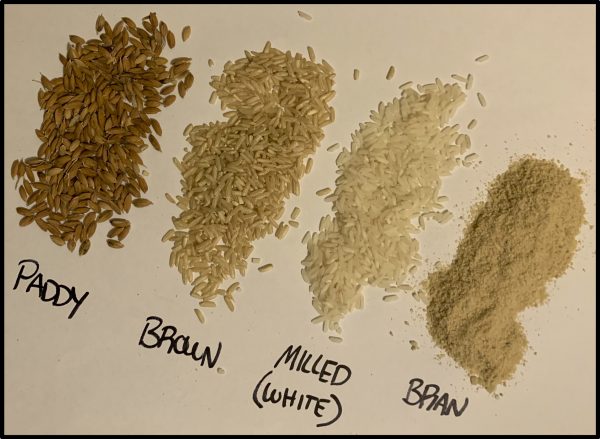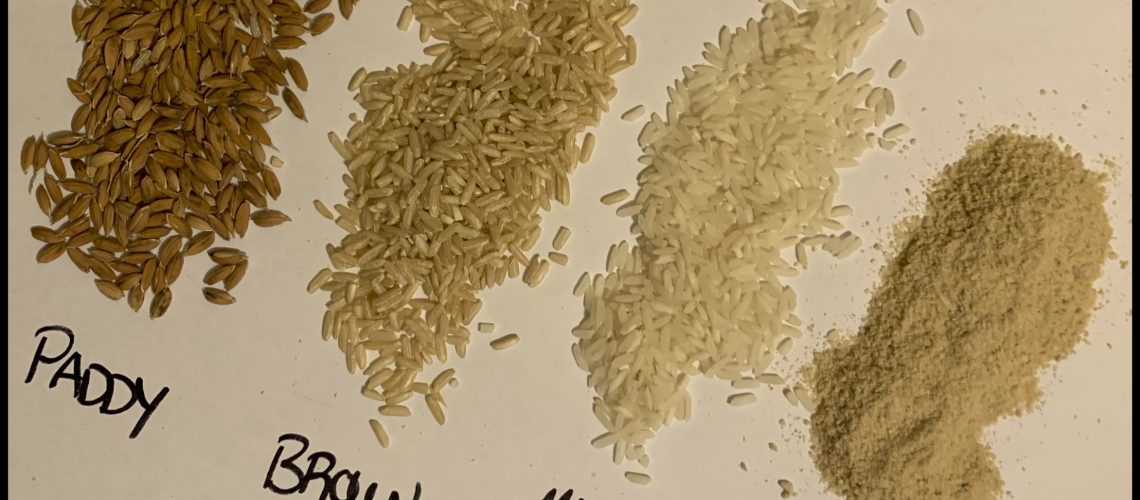Guest Post By Kristopher Parker, 2019-2020 Sustainability Leadership Fellow and Postdoctoral Fellow in the Department of Environmental & Radiological Health Sciences
****
It is late. My brain is firing on half of its cylinders at best. I pack up my computer, strap on my bicycle helmet, and mentally prepare myself for the icy winter air while wondering whether I saw the sun today. As I descend the stairs pondering the genre of music that shall accompany me on my commute home, a banner flashes across my screen.
A text from my mother. And it reads, “What the heck is in this box?”
I have absolutely no context. I begin to type … “I’ll call when I get” …
A second text, “It’s tan. And it feels, well, gritty.”
That’s it. A spark of memory reminds me of the package I dropped in the mail three weeks ago.
“It’s rice bran, mom. That’s what I am studying now, remember? You’re supposed to eat it.”
****

Major rice producing communities experience high rates of poverty, malnutrition, intestinal infections, and chronic gut disease underscoring a need for practical solutions that combat these issues. Diet represents one such practical factor. Nearly half of the human population depends upon rice as a primary source of nourishment and energy. From a number’s perspective, the global production of paddy rice in 2018 was estimated near 760 million metric tons, about two-thirds of which was milled into the form of rice most commonly consumed by humans: white rice. The milling process to convert paddy rice into shelf-stable white rice strips the rice grain of its outer bran layer, resulting in nutrient loss while also generating excessive agricultural waste. About 50-60 million metric tons of rice bran annually. To make those numbers slightly easier to digest:
The weight of rice bran produced in the world each year is roughly 3 times the estimated weight of the entire U.S. population, or approximately equivalent to 10 million African elephants or the weight of 5 million yellow school buses; an amount that could bus 300 million kids to school to learn about sustainability.
Rice bran is primarily used in animal feed for cattle and horses, although a substantial amount is left to waste. On much smaller scales, rice bran has been used in some very creative ways: a pickling agent for fermenting vegetables in Japan; extraction of its oils for cooking, which produces defatted rice bran as another byproduct; incorporation into sunscreens, body washes, makeup removers, and face creams; a component in cutting boards; and, this is a new one for me, a coating on the surface of ice blocks to prevent melting. What else is there to do with 5 million school buses worth of rice bran? Eat it! That’s what our research shows, anyway.
From a nutrition perspective, a 30-gram serving of rice bran can deliver almost a quarter of the daily requirement of fiber and well over half the requirements for a variety of B vitamins in addition to minerals such as iron and magnesium. But wait, there’s more. Rice bran also contains E vitamins, proteins, fats and oils, antioxidants, and an entire suite of disease-fighting phytochemicals and prebiotics. Phytochemicals are compounds produced by plants that typically are not considered nutrients. Prebiotics are nondigestible compounds that provide nutrients, not for us, but for some of the trillions of tiny creatures that inhabit our intestines. Individually these creatures are called microbes, the collective set of these trillions of creatures are referred to as the gut microbiome, and the creatures that feast on prebiotic compounds are called probiotics. It is typically a good thing for our health to make sure they stick around. This is all where my interests really entered the fold.
I absolutely adore microbes and microbiology and somewhere along the way I picked up the computer coding skills necessary to explore the complex relationships between the gut microbiome and human health. When I had an opportunity to add an additional layer of complexity to that mixture, I jumped at the chance and joined a research group investigating the intricate interplay between gut microbes, the components in rice bran, the profile of products (called metabolites) that are produced when a person or an animal consumes food, and how all of these influence health. Our findings in humans, dogs, mice, and other animals have shown that consumption of rice bran provides valuable nutrition, can promotes probiotics, reduce harmful gut microbes (called pathogens), and confer protection from chronic gut diseases.
In conjunction with its low cost and ease of accessibility, the utilization of rice bran as a functional food represents a promising, and practical sustainable solution to reduce waste in the global supply chain while also promoting gut heath and improving quality of life.
****
A third message from my mother reads, “How do I eat it?”
I think about all of the ways that rice bran has been added to the things concocted in my kitchen… stews, soups, sauces, smoothies, seasonings, salsas, guacamole, tacos, nachos, beans, tacos, doughs, breads, tacos, cookies, brownies… even the cats and dogs have it with their meals… but there is one thing I will never add it to, vanilla ice cream, that is a sacred treat.
As I dial her number, I remind myself to call my mother more often, and to maybe send her a handful of recipes alongside the box of tan, gritty powder with no other context.
****
Disclaimer: Finding rice bran locally may be a near-impossible task. I have chosen not to include any links to purchase rice bran as I do not wish to make any kind of official endorsement. My advice is this: read the description of the product. If nutrition information isn’t listed, run away. Pay careful attention to avoid buying anything that says “rice bran solubles” or “rice bran fiber” or “rice bran supplement.” There are reputable vendors out there. If you buy raw rice bran, you can make it last longer by “heat-stabilizing” it in the oven at 300 degrees Fahrenheit for 10 minutes. If you’re making brownies, try substituting a ½ cup of flour with a ½ cup of rice bran. And if you’re having ice cream with those brownies, leave the rice bran in the freezer.
If all else fails, you can contact me via the information listed at https://github.com/kdprkr.






